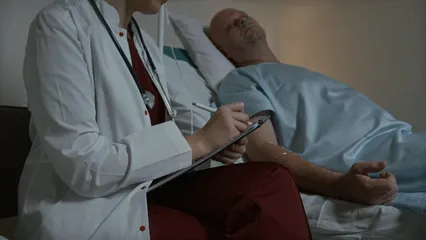
Why Do We Get Pins and Needles in Our Limbs?
Introduction
Have you ever felt that strange, prickly sensation in your limbs? You know, the one that feels like tiny needles are dancing on your skin? Medically, this phenomenon is known as paresthesia. It’s quite common and often occurs after sitting in an awkward position for too long, like when you’ve been crossing your legs or resting your arm on a hard surface. Most of the time, these sensations are temporary, lasting only a few minutes. However, understanding why they happen is essential, especially if they become a frequent visitor in your life. Knowing the causes, symptoms, and potential underlying conditions can help you distinguish between harmless occurrences and those that might require medical attention.
Understanding the reasons behind sensations like pins and needles can enhance your health awareness. Why do we get pins and needles in our limbs
Understanding Pins and Needles
What Are Pins and Needles?
Pins and needles sensations are described as a mix of tingling, burning, or numbness. Imagine your nerve endings throwing a surprise party, and you’re the uninvited guest! This sensation is often triggered when nerves are compressed, cutting off their blood supply. When you finally change your position, the nerves wake up, and the sensations can become quite pronounced.
Typically, this prickly feeling occurs in your arms, legs, hands, or feet. It’s like your body’s way of saying, “Hey! I need a little attention over here!” The duration of these symptoms can vary widely. For most people, the sensations resolve within minutes. However, if you’re experiencing significant discomfort or the sensation lasts longer than usual, it might indicate an underlying issue.
Pins and needles can pop up in various everyday scenarios. For instance, have you ever sat too long in a movie theater seat, only to stand up and feel like your leg has turned into jelly? Or perhaps you’ve awakened from a deep slumber, only to find your arm feeling utterly unresponsive? These moments, while annoying, are usually nothing to worry about.
However, if you’re finding yourself frequently plagued by these sensations, it’s wise to consult a healthcare professional. Persistent pins and needles might be your body’s way of signaling that something else is going on beneath the surface. So, pay attention! The next time those pesky needles come knocking, it might be worth investigating further.
Common Areas Affected
Pins and needles sensations can be quite annoying, often sneaking up on you when you least expect it. Typically, you may feel this prickling sensation in your arms, hands, legs, or feet. It’s like your nerves decided to throw a mini party, and you’re the only one not invited!
When it comes to specific areas, your hands and feet tend to be the most popular guests at the pins and needles soirée. Ever sat cross-legged for too long? Congratulations, your legs have joined the club! The sensation in your fingers can vary from a gentle tingling to a more intense burning feeling. Meanwhile, your feet might feel like they are being tickled by tiny elves.
Interestingly, the intensity and type of sensation can differ based on where you experience it. For instance, if your hand is feeling that familiar prickly buzz, it may mean that the median nerve is a little cramped. On the other hand, if your leg is tingling, it could be caused by pressure on the sciatic nerve.
In some cases, you might even notice that the sensation is stronger in certain positions. For example, lying on your arm while binge-watching your favorite show? That’s a recipe for a fiery wake-up call when you finally shift positions!
So, the next time you feel those pesky pins and needles, take a moment to appreciate the quirky nature of your nerves. They all have their own stories to tell, depending on the area of your body they’ve decided to entertain.
Speaking of comfort while sitting, why not consider investing in an Ergonomic Office Chair? It could help reduce those pesky sensations by promoting better posture and blood flow. Your back will thank you!
Causes of Pins and Needles
Temporary Causes
Now that we’ve covered the common hangouts for pins and needles, let’s talk about what causes these sensations to crash the party. Temporary pins and needles often result from pressure on nerves, usually from staying in one position far too long. Imagine sitting in a movie theater, popcorn in one hand and your leg twisted under you. The moment you stand up, your leg feels like a block of ice. That’s your nerve saying, “Help! I need blood flow!”
Tight clothing can also contribute to this prickly feeling. Ever tried wearing those trendy yet constricting shoes? Your feet might protest with a chorus of tingles, signaling that they need a breather. When blood flow is restricted, nerves signal the brain, creating that classic pins and needles sensation.
Another common culprit is hyperventilation. When you’re anxious and take rapid breaths, your body may react by sending tingles to your hands and feet. It’s like a surprise visit from the tingling fairy, but not one you asked for!
The good news is that these sensations are usually harmless and resolve quickly once you change your position or loosen that tight belt. So, if your limbs start feeling a little prickly, just shift around or loosen up! Your nerves will thank you, and you can get back to enjoying your day without the uninvited guests of pins and needles.

Speaking of relieving discomfort, consider trying a Heating Pad. It can help soothe your muscles and improve blood flow, making those annoying sensations a thing of the past!
In summary, pressure on nerves, tight clothing, and rapid breathing are the main temporary causes of those pesky sensations. They can be annoying but are often short-lived, reminding us to give our body the love and space it needs!
Medical Conditions Linked to Pins and Needles
Pins and needles can be more than just an annoying sensation; they can signal underlying health issues. Chronic or severe cases may stem from various medical conditions. Understanding these conditions is crucial for effective management and treatment. Let’s break down some of the key culprits behind persistent pins and needles.
Diabetes
Diabetes is a common offender when it comes to pins and needles. This condition can lead to peripheral neuropathy, a type of nerve damage that often begins in the feet and progresses upward. Individuals with diabetes may experience tingling, numbness, or burning sensations, particularly in their extremities. The damage occurs due to prolonged high blood sugar levels, which can affect the small blood vessels that supply nerves. Symptoms can be quite distressing, often leading to difficulties in balance and coordination.
Managing blood sugar levels is essential. Without proper control, nerve damage can worsen, resulting in more severe symptoms and complications, including infections. Regular check-ups and lifestyle modifications, such as diet and exercise, can help mitigate these risks. Speaking of which, consider boosting your health with some Vitamin B12 Supplements to support your nerve health!

Multiple Sclerosis
Multiple sclerosis (MS) is another condition that can cause abnormal sensations, including pins and needles. MS is an autoimmune disease where the immune system mistakenly attacks the protective myelin sheath covering nerve fibers. This demyelination can disrupt nerve signals, leading to a host of symptoms, including tingling and numbness in various parts of the body.
Individuals with MS may experience these sensations alongside other symptoms like muscle weakness, difficulty with coordination, or vision problems. The unpredictable nature of MS can make each episode unique, requiring careful monitoring and management. Early intervention and treatment can help manage symptoms and slow disease progression.
Sciatica
Ah, sciatica—the classic pain in the backside! This condition occurs when the sciatic nerve, which runs from the lower back down to the legs, is compressed or irritated. Common causes include herniated discs, spinal stenosis, or even tight muscles in the buttock region. When this nerve is pinched, it can lead to a range of symptoms, including sharp pain, tingling, and pins and needles sensations that may radiate down the leg.
People with sciatica often find relief through physical therapy, stretching exercises, or medications to manage inflammation and pain. However, for more severe cases, surgical intervention may be necessary to relieve nerve compression. Why not keep your muscles limber with a Foam Roller? It’s great for releasing tension in those tight muscles!

Other Conditions
While diabetes, MS, and sciatica are prominent players, several other conditions can contribute to pins and needles sensations:
- Raynaud’s Disease: This condition affects blood flow, primarily to the fingers and toes, often triggered by cold temperatures or stress. During an episode, affected areas may turn pale or blue, followed by tingling as blood flow returns.
- Carpal Tunnel Syndrome: Compression of the median nerve at the wrist can cause numbness and tingling in the hand and fingers, particularly the thumb, index, and middle fingers. This condition is often exacerbated by repetitive wrist movements.
- Vitamin Deficiencies: Deficiencies in B vitamins, particularly B12, can lead to nerve damage and result in pins and needles. A balanced diet is crucial for nerve health.
- Peripheral Neuropathy: Various factors, including alcohol abuse and exposure to toxins, can lead to this condition, causing numbness and tingling, especially in the hands and feet.
Persistent pins and needles should not be ignored. If you experience these sensations regularly, it’s essential to consult a healthcare provider to explore underlying conditions and develop a tailored treatment plan.
Diagnostic Procedures
When it comes to diagnosing the elusive pins and needles sensation, a thorough approach is essential. Physicians often start with a comprehensive medical history. This helps identify any patterns or triggers. For instance, did you just binge-watch a series while sitting cross-legged? Or maybe you’ve been wearing those fashionable shoes that squeeze your feet? Knowing these details can be crucial.
Blood tests are a common first step. They can reveal underlying conditions like diabetes or vitamin deficiencies. If your doctor suspects nerve damage, they might order nerve conduction studies (NCS) or electromyography (EMG). These tests measure the electrical activity in your nerves and muscles, helping pinpoint any dysfunction.
Imaging tests like X-rays, MRIs, or CT scans may be performed if structural issues are suspected. These can help visualize nerve compression or damage. For example, if there’s a herniated disc in your spine, it could be pinching a nerve, leading to that pesky tingling.
Remember, each diagnostic tool provides a piece of the puzzle. It’s like assembling a jigsaw with several pieces missing. By combining all this information, healthcare providers can better understand what’s causing your symptoms. So, don’t shy away from sharing even the smallest details about your lifestyle and symptoms. They could be the key to unlocking the mystery of your pins and needles!

When to Seek Help
While the sensation of pins and needles is often harmless, certain symptoms signal a need for immediate medical attention. If you experience sudden tingling accompanied by weakness in your limbs, it’s time to get serious. Any sudden onset of numbness, especially if it affects one side of your body, could indicate a stroke. If you notice slurred speech or facial drooping, don’t wait—call for help!
Other concerning signs include difficulty walking, loss of coordination, or changes in vision. These symptoms can indicate serious underlying conditions that require prompt evaluation. Additionally, if the tingling persists or worsens, it’s advisable to consult a healthcare professional. Self-diagnosing might lead you astray; after all, the internet can only provide so much insight.
Remember, your body knows best. If something feels off, trust those instincts. It’s better to be safe than sorry, especially when it comes to nerve-related symptoms. So, keep those communication lines open with your doctor and don’t hesitate to seek help when needed. Your health deserves the attention!
Treatment Options
Home Remedies and Lifestyle Changes
When those pesky pins and needles sensations strike, immediate relief is often just a position change away. If you’re feeling the prickly annoyance, try shifting your weight or standing up to relieve the pressure on your nerves. Loosening tight clothing or shoes can also work wonders. Think of it as giving your body a little pep talk: “Hey there, buddy! Time to wake up!”
But what if these sensations keep crashing your party? Prevention is the name of the game. If you have diabetes, managing your blood sugar levels is crucial. High glucose can lead to peripheral neuropathy, which loves to play host to pins and needles. A balanced diet, regular exercise, and routine check-ups can help keep your blood sugar in check and those sensations at bay.
Alcohol consumption is another area to consider. While a glass of wine might sound tempting, excessive drinking can lead to nerve damage, resulting in chronic pins and needles. Sipping in moderation can help keep your nerves happy and your body feeling good.
Incorporating regular physical activity into your routine can also help. Exercise boosts blood circulation, giving your nerves the attention they need. Whether it’s a brisk walk or a fun dance session, moving your body helps keep those tingles at bay. And if you’re looking for a way to track your fitness journey, consider a Fitness Tracker to keep you motivated!
Stretching and maintaining good posture are essential too. If you find yourself in a job that requires long hours at a desk, remember to take breaks. Stand up, stretch, and give your limbs a little shake. Your body will thank you, and those pins and needles won’t have a chance to settle in.
Lastly, consider supplementing your diet with essential vitamins, especially B vitamins. Vitamin B12, in particular, is crucial for nerve health. A deficiency can lead to increased likelihood of pins and needles. So, munch on those leafy greens, nuts, and eggs to keep your B vitamin levels up!
In summary, immediate relief can come from changing positions or loosening tight clothing. Long-term strategies include managing diabetes, reducing alcohol intake, exercising regularly, and ensuring you get enough essential vitamins. By adopting these home remedies and lifestyle changes, you can banish those annoying sensations and keep your limbs feeling fabulous!

Medical Treatments
For chronic or severe cases of pins and needles, medical treatments may be necessary. The first step is often to identify the underlying cause. Once that’s established, a range of treatment options can help alleviate the symptoms.
Medications are commonly prescribed for conditions leading to persistent pins and needles. Pain relievers, such as acetaminophen or non-steroidal anti-inflammatory drugs (NSAIDs), may provide relief from discomfort. In cases of nerve pain, anti-seizure medications like gabapentin can be effective. These meds work by stabilizing nerve activity, helping to reduce the irritating sensations.
If the pins and needles are linked to diabetes, managing blood glucose levels is paramount. This might involve insulin therapy or oral medications aimed at keeping blood sugar in check. Regular monitoring and lifestyle changes, such as diet and exercise, are also vital components of diabetes management.
Physical therapy can be a game changer for those suffering from conditions like sciatica or carpal tunnel syndrome. A physical therapist can teach exercises to strengthen muscles and improve flexibility. This helps relieve pressure on affected nerves and promotes better overall function. Imagine your nerves getting a spa day every time you stretch and strengthen!
In more severe cases, surgical intervention may be necessary. For instance, if a compressed nerve is the culprit, such as in carpal tunnel syndrome, surgery may be performed to relieve pressure. This can involve cutting a ligament to create more space for the nerve. Similarly, if sciatica is caused by a herniated disc, surgery to remove the disc material might be required. While surgery sounds intense, it can lead to significant relief for those suffering from chronic symptoms.

Lastly, alternative treatments like acupuncture or chiropractic care may also offer relief from persistent pins and needles. These therapies focus on restoring balance and alleviating nerve compression, helping to reduce symptoms. And for a little extra relaxation, don’t forget to try an Essential Oil Diffuser to create a calming atmosphere!
In conclusion, medical treatments for chronic pins and needles depend on the underlying condition. Medications, physical therapy, and surgical options are available to help manage symptoms effectively. If you’re dealing with persistent sensations, consulting a healthcare provider is the best way to find a tailored treatment plan that suits your needs.
FAQs
Please let us know what you think about our content by leaving a comment down below!
Thank you for reading till here 🙂
And if you’re looking for some cozy relaxation, a Weighted Blanket might just be the perfect companion to snuggle with while you read or relax!
All images from Pexels




